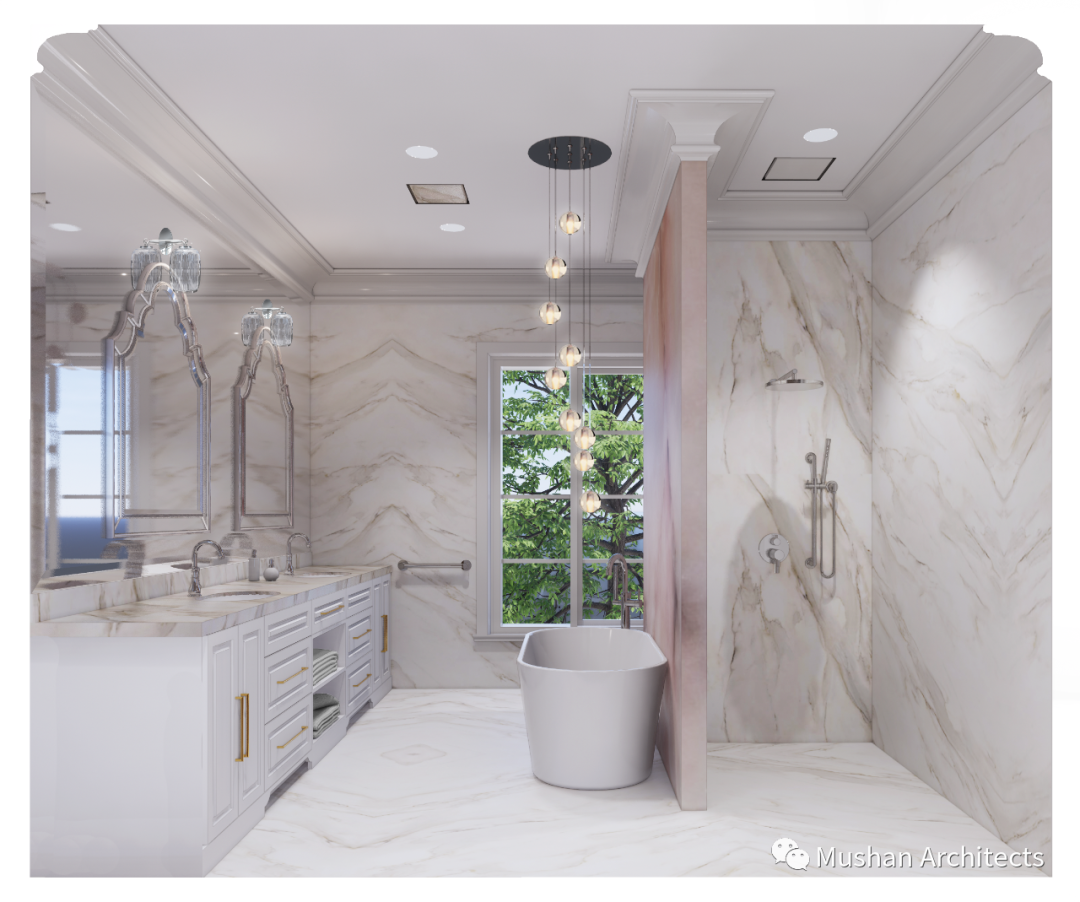2) Installation area proportion for double slope roof, only the south slope is suitable for installation, which is about 50% of the roof area; For the four slope roof, the south slope is preferred, and the East and West slopes can also be installed.
In conventional large-scale public buildings, the depth direction of the building is generally not less than 20m and not more than 50m, and considering the seismic demand, the length width ratio is generally not more than 6.
These facades can be used to install photovoltaic modules.
When the area of the standard floor is smaller, the ratio tends to be larger, so it should be taken as 0.28.
Schematic diagram of installation scope of non curtain wall facade of public buildings ② building shelter The occlusion problem is mainly divided into two situations: one is the external environment occlusion, which is mainly the occlusion of other surrounding buildings; The other is the shelter of the building itself, which is mainly caused by the concave convex facade required by the architectural modeling..
To sum up, the installation positions of photovoltaic components applicable to different types of buildings are shown in Table 1.
② Roof staircase and elevator machine room These structures protruding from the roof are generally more than 4m, and their shadow will cause loss to the installation area of building photovoltaic system, and the impact range is generally about 4m.
Except that some equipment occupies the land, other spaces are suitable for the installation of photovoltaic systems.
Photovoltaic information | PV info solar building | rapid estimation method of building photovoltaic system installation area in the early stage of design “30.60” double carbon goal is put forward.
③ Parapet Considering the maintenance needs of building photovoltaic system installation, it is generally set as accessible roof, and the parapet is considered as 1.5m, with the shadow range of 3M South parapet and 2m East-West parapet.
In office buildings The main use space has high requirements for daylighting, while the auxiliary space has low requirements for daylighting.
The combination of photovoltaic and building is one of the most important fields in photovoltaic application.
When installing photovoltaic systems in these types of buildings, the factors affected mainly include the following aspects: ① building equipment The impact on the installation scale of photovoltaic system mainly includes three aspects: the occupied area of the equipment system itself, the surrounding safety distance and the shadow shielding of the equipment system.
Green building, that is, the clean energy building application represented by photovoltaic, has ushered in a period of rapid development opportunities.
In cultural architecture The building form has strong integrity, and the facade elements are relatively regular, mostly large-area walls or glass curtain walls; The indoor daylighting is mainly solved by electrical lighting, and the requirements for natural daylighting are slightly lower.
The wall or curtain wall corresponding to this part of the space can be used to install photovoltaic modules; In addition, office buildings have certain requirements for sunshade, and external photovoltaic sunshade components can be set in combination with sunshade function.
As the installation of photovoltaic system on the north slope of the roof is too inefficient, it is not recommended to install it.
01 In the engineering application of the installable parts of photovoltaic modules in different building types, the parts that can be used to install photovoltaic modules in the building mainly include roof, facade wall, curtain wall, sunshade components and so on.
Large commercial buildings The lighting of buildings mainly depends on internal lighting.
The installation area is about 70% of the roof area.
The feasibility and priority analysis of Installing Photovoltaic Systems on common types of building facades are as follows.
Developing green buildings, promoting clean energy, low-carbon, efficient and safe utilization will become an important way to achieve carbon peak, carbon neutralization and task goals.
The sunshine area coefficient of the building facade suitable for the installation of photovoltaic system is equal to the ratio of the sum of the facade areas in the south, East and west to the total building area, that is, the ratio of the sum of the facade areas of a single layer to the area of the standard floor, that is, 0.26 ~ 0.28.
Therefore, the facade resources can be fully used to install photovoltaic modules.
Combined with engineering practice, the installable parts of photovoltaic system in different types of buildings are studied, and the calculation method of installable area of photovoltaic modules is deduced, which provides an economic calculation basis for the promotion of photovoltaic buildings.
Same building area (2000m2) ) For the side lengths of different plane shapes, in order to avoid the western sun, most of the buildings are oriented in the north-south direction.
2) Wall installation proportion ① window area For non curtain wall public buildings, the window wall ratio of the south facade is generally 0.4 ~ 0.7; In order to reduce the impact of western sun on buildings, the window wall ratio is generally 0.2 ~ 0.6; In comprehensive consideration, the window wall ratio of non curtain wall is about 0.5, and the installable area accounts for about 0.5 of the facade area.
520 ~ 560m2.
Taking the standard floor building area of 2000 ㎡ as an example, under the same building area, the plane shape deformation range is 44.7m × 44.7m~20m × 100m, i.e.
④ Maintenance channel of photovoltaic system When installing photovoltaic system on flat roof, it is generally arranged according to photovoltaic array, and maintenance channel is generally reserved between each row, with a width of about 1.2m.
Under the same building area, the building facade area of different building forms is different.
Most facades are glass curtain walls or large-area solid walls.
Residential building As the living space has high requirements for natural lighting, there are many windows on the main facade of the building, the real wall is small and scattered, and the economy of Installing Photovoltaic system is low, it is not suitable to install photovoltaic modules on the facade.
When estimating according to the relevant indicators of the regulatory detailed planning, the building density index can be directly used for estimation, that is, the installable area = the building base area × 70% = land area × Building density × 70%。 Wall installation 1) sunshine area coefficient of building facade in order to facilitate the estimation of the installation scale of photovoltaic system on the facade in the early stage of the project, the research group introduced the concept of “sunshine area coefficient of Building Facade”, that is, the ratio of the total area of facade capable of receiving solar radiation to the total building area of the building.
Due to the trigonometric function relationship of the angle between the sloping roof and the ground level, when the slope is 30 °, the roof area is about 1.15 times of the horizontal projection area.
3) When the installation area is estimated according to the relevant indicators of the regulatory detailed planning, the building density index can be directly used for estimation, that is, the installable area = the building base area × 60% = land area × Building density × 60%。 Installation position of double roof installation position of four slope roof installation position of flat roof installation 1) factors affecting the installation proportion of flat roof the working condition of simultaneous application of photovoltaic system and flat roof mainly exists in large-scale commercial, cultural, hospital and other types of buildings.
Installation positions of photovoltaic modules in different types of buildings 02 Installation area proportion of photovoltaic system in different building parts: installation of sloping roof 1) influencing factors of sloping roof installation proportion: sloping roof is mainly used in low-rise residential buildings, with north-south orientation and gradient between 20 ° and 35 °.
Since the North facade is not suitable for the installation of photovoltaic system, the sum of the side lengths in the south, East and west directions is 130m ~ 140m if the north side length of the standard floor is removed.
The importance of natural lighting is lower than that of residential buildings.
its plane perimeter is 179m ~ 240m.
The impact range is about 2m around the boundary of the equipment area.
Because the roof is not regular and the height is staggered under normal circumstances, 60% of the horizontal projection area can be calculated when estimating the roof installation area.
Except for high-rise residential buildings, the roofs of other types of buildings are generally less sheltered.
When installing photovoltaic system on flat roof, the installable area shall be considered as 70% of the roof area.
The height of most public buildings is about 4m, so the sum of the south, East and West facade areas of the standard floor is 130 × 4 to 140 × 4, i.e.
Schematic diagram of influencing factors and installation scope of roof photovoltaic system installation 2) the proportion of installation area comprehensively considers the influence of the above equipment, staircase and elevator machine room, parapet, photovoltaic system maintenance channel and other factors.
The facade installation has different requirements for different types of building modeling characteristics and use function requirements, and the priority of photovoltaic system installation in the facade is also different.




